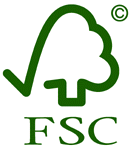| Text
by:
The Swedish FSC Council (ed) 1998 compiled by:
|
The Forest Stewardship CouncilFSC |
 |
What is the FSC?The Forest Stewardship Council (FSC) is an independent international organisation with its headquarters in Mexico. Its aim is to encourage the environmentally responsible, socially beneficial and economically viable management of the world's forests.The FSC promotes a voluntary accreditation programme for organisations and enterprises that certificate forestry. The FSC's Principles and Criteria contain overall forestry management guidelines that may be generally applied all over the world. The system of certification, however, is to be adapted to the local conditions that apply in different countries, and one of the FSC’s most important tasks is therefore to support the work of developing the Swedish FSC Standard. The Swedish FSC Working Group was formed on February 15, 1996 for the purpose of producing a proposal for the Swedish FSC Standard to be submitted to the FSC for approval. The Working Group, which is made up of representatives of social, environmental and economic interests, was reformed on May 7, 1997. (Swedish FSC Standard, p 6) |
Why the FSC is necessary.The photosynthesis of green plants using solar energy as an energy source is the basis for development towards a globally sustainable utilisation of resources. Responsibly managed forests are of great importance in providing the growing global population with multiple-use renewable raw materials, and energy.Forestry is an important cornerstone of Sweden's prosperity, and of a community that will be sustainable in the future. At the national level, the FSC process aims to promote the management and use of forests in ways that are ecologically, socially and economically sustainable. Sweden's forest landscape has been exploited for centuries, and the percentage of natural forest that is barely affected is very small. To achieve its ecological and social objectives, society must assume a significant economic responsibility in addition to the voluntary commitments of certified landowners. (Swedish FSC Standard, p 7) |
|
Development of the Swedish FSC-standardThe FSC's Principles and Criteria constitute an overall framework for the development of a national suitable standard. They are not intended to be employed as the sole basis for certification. National standards are developed to comply with local ecological, social and economic conditions, while simultaneously embodying the FSC's fundamental Principles and Criteria. When a set of standards has been approved by the FSC, all local and international certifiers must apply these standards as a minimum requirement in their certification processes.The work with formulating a national FSC-standard was initiated 15th of February 1996, when the Swedish FSC Working group was formed. After one and a half year of intense work the proposed Swedish FSC-standard was submitted to FSC for approval in September 1997. The Swedish standard was principally approved in January 1998, and after minor corrections, finally endorsed 5th May 1998. The stakeholders supporting the proposed standard were: Swedish Union of Forest workers, the Swedish Forest Industry Workers Union, the national Union of Sami People, the World Wildlife Fund for Nature, the Swedish Society for Nature conservation, the Swedish Youth Association for Environmental Studies and Conservation, the Swedish Forest Industries Association, the Church of Sweden, the Forestry Society, Kinnarps AB, and IKEA of Sweden (Swedish FSC Standard, p 3) |
|
What does FSC stand for?Certification in accordance with the FSC regulations signifies that the enterprise/landowner carries on environmentally responsible, economically viable, socially beneficial forestry management that complies with all applicable laws and regulations, the FSC Principles and Criteria and the Swedish FSC Standard. This certification also allows forest products from certified land holdings to be marked with the FSC symbol in forms decided by the FSC.The objective is to manage and use forest and forest land in forms that:
Certification in accordance with the Swedish FSC Standard means that the landowner accepts that this Standard, on the basis of new knowledge and experience, be changed to better meet the objective by means of recurring reviews carried out by a national FSC representative body that is consensus-oriented in its work, and made up of representatives of the parties involved. (Swedish FSC Standard, p 7) |
|
Focusing on the
Sámi: Chapter 4.2 -
4.2.1. Areas of Reindeer
Husbandry
|
|
| Reference:
The Swedish FSC Council (ed): Swedish FSC Standard for Forest Certification. (English Version). Uppsala 1998. |